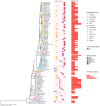T6SS: A Key to Pseudomonas's Success in Biocontrol?
- PMID: 38004732
- PMCID: PMC10673566
- DOI: 10.3390/microorganisms11112718
T6SS: A Key to Pseudomonas's Success in Biocontrol?
Abstract
Bacteria from the genus Pseudomonas have been extensively studied for their capacity to act as biological control agents of disease and pests and for their ability to enhance and promote crop production in agricultural systems. While initial research primarily focused on the human pathogenic bacteria Pseudomonas aeruginosa, recent studies indicate the significance of type VI secretion (T6SS) in other Pseudomonas strains for biocontrol purposes. This system possibly plays a pivotal role in restricting the biological activity of target microorganisms and may also contribute to the bolstering of the survival capabilities of the bacteria within their applied environment. The type VI secretion system is a phage-like structure used to translocate effectors into both prokaryotic and eukaryotic target cells. T6SSs are involved in a myriad of interactions, some of which have direct implications in the success of Pseudomonas as biocontrol agents. The prevalence of T6SSs in the genomes of Pseudomonas species is notably greater than the estimated 25% occurrence rate found in Gram-negative bacteria. This observation implies that T6SS likely plays a pivotal role in the survival and fitness of Pseudomonas. This review provides a brief overview of T6SS, its role in Pseudomonas with biocontrol applications, and future avenues of research within this subject matter.
Keywords: Pseudomonas; biocontrol; type VI secretion system.
Conflict of interest statement
The authors declare no conflict of interest.
Figures



Similar articles
-
The T6SSs of Pseudomonas aeruginosa Strain PAO1 and Their Effectors: Beyond Bacterial-Cell Targeting.Front Cell Infect Microbiol. 2016 Jun 9;6:61. doi: 10.3389/fcimb.2016.00061. eCollection 2016. Front Cell Infect Microbiol. 2016. PMID: 27376031 Free PMC article. Review.
-
Engineering the T6SS of Pseudomonas for targeted delivery of antibacterial and antifungal effectors.J Biol Eng. 2025 Apr 3;19(1):28. doi: 10.1186/s13036-025-00497-w. J Biol Eng. 2025. PMID: 40176102 Free PMC article.
-
A Pseudomonas aeruginosa type VI secretion system regulated by CueR facilitates copper acquisition.PLoS Pathog. 2019 Dec 2;15(12):e1008198. doi: 10.1371/journal.ppat.1008198. eCollection 2019 Dec. PLoS Pathog. 2019. PMID: 31790504 Free PMC article.
-
Identification and Comparative Genomic Analysis of Type VI Secretion Systems and Effectors in Klebsiella pneumoniae.Front Microbiol. 2022 May 12;13:853744. doi: 10.3389/fmicb.2022.853744. eCollection 2022. Front Microbiol. 2022. PMID: 35633723 Free PMC article.
-
The type VI secretion system: a multipurpose delivery system with a phage-like machinery.Mol Plant Microbe Interact. 2011 Jul;24(7):751-7. doi: 10.1094/MPMI-11-10-0262. Mol Plant Microbe Interact. 2011. PMID: 21361789 Review.
Cited by
-
A comprehensive review of the pathogenic mechanisms of Pseudomonas aeruginosa: synergistic effects of virulence factors, quorum sensing, and biofilm formation.Front Microbiol. 2025 Jul 21;16:1619626. doi: 10.3389/fmicb.2025.1619626. eCollection 2025. Front Microbiol. 2025. PMID: 40761286 Free PMC article. Review.
-
Magnesium oxide nanoparticles reduce clubroot by regulating plant defense response and rhizosphere microbial community of tumorous stem mustard (Brassica juncea var. tumida).Front Microbiol. 2024 Mar 20;15:1370427. doi: 10.3389/fmicb.2024.1370427. eCollection 2024. Front Microbiol. 2024. PMID: 38572228 Free PMC article.
-
Pseudomonas in Meat Processing Environments.Foods. 2025 May 2;14(9):1615. doi: 10.3390/foods14091615. Foods. 2025. PMID: 40361697 Free PMC article. Review.
-
Comparative genomics-based insights into Pantoea ananatis strains, isolated from white spot diseased leaves of maize with plant growth-promoting attributes.Appl Environ Microbiol. 2025 Jun 18;91(6):e0032925. doi: 10.1128/aem.00329-25. Epub 2025 May 19. Appl Environ Microbiol. 2025. PMID: 40387325 Free PMC article.
-
Key findings from 15 years of Mangrovibacter research: a generalist bacterium beyond endophytes.Appl Environ Microbiol. 2025 Aug 20;91(8):e0247924. doi: 10.1128/aem.02479-24. Epub 2025 Jul 10. Appl Environ Microbiol. 2025. PMID: 40637407 Free PMC article. Review.
References
-
- Pal K.K., McSpadden Gardener B. Biological Control of Plant Pathogens. Plant Health Instr. :2006. doi: 10.1094/PHI-A-2006-1117-02. - DOI
-
- US EPA What Are Biopesticides? [(accessed on 11 August 2023)]; Available online: https://www.epa.gov/ingredients-used-pesticide-products/what-are-biopest....
Publication types
Grants and funding
LinkOut - more resources
Full Text Sources

